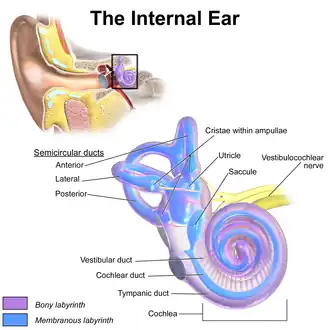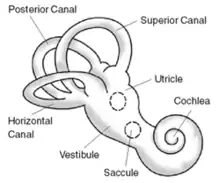Inner ear
The inner ear is the innermost part of the vertebrate ear. It is mainly responsible for sound detection and balance.[1] In mammals, it consists of two main working parts inside a bony labyrinth: [2]
- The cochlea, dedicated to hearing; converting sound pressure patterns from the outer ear into electrochemical impulses which are passed on to the brain via the auditory nerve.
- The balance system. This has three semi-circular canals, which are set at right angles to each other.
| Inner ear | |
|---|---|
 | |
| Details | |
| Artery | labyrinthine artery |
| Identifiers | |
| Latin | auris interna |
| MeSH | D007758 |
| TA | A15.3.03.001 |
| FMA | 60909 |
| Anatomical terminology | |

Inner ear diagram
The inner ear is found in all vertebrates, with many variations in form and function. The inner ear is supplied with the eighth cranial nerve in all vertebrates.
References
- Torres, M., Giráldez F. 1998. The development of the vertebrate inner ear. Mechanisms of Development 71 (1-2) pg 5-21
- J.M. Wolfe et al. 2009. Sensation and perception. 2nd ed. Sunderland: Sinauer.
This article is issued from Wikipedia. The text is licensed under Creative Commons - Attribution - Sharealike. Additional terms may apply for the media files.